The Development and Application of an Intelligent Assessment and Strategy Implementation System for Non-Intellectual Factors in Mathematics Learning Among Senior High School Students
Abstract
:1. Introduction
1.1. Literature Review
1.1.1. Non-Intellectual Factors
1.1.2. The Relationship Between Non-Intellectual Factors and Academic Achievement in Mathematics
1.1.3. Assessment Tools for Non-Intellectual Factors in Mathematics
1.2. Research Questions
2. Methodology
2.1. Development of the Intelligent Assessment and Strategy Implementation System
2.1.1. Research Design for the Development of the Intelligent Assessment and Strategy Implementation System
2.1.2. Research Tools for the Development of the Intelligent Assessment and Strategy Implementation System
2.2. Application of the Intelligent Assessment and Strategy Implementation System
2.2.1. Research Design for the Application
2.2.2. Participants
2.2.3. Research Tools for the Application
3. Results
3.1. Development of the Intelligent Assessment and Strategy Implementation System
3.1.1. The Development Process of the Intelligent Assessment and Strategy Implementation System
3.1.2. Functions of the Intelligent Assessment and Strategy Implementation System
3.2. Application of the Intelligent Assessment and Strategy Implementation System
3.2.1. Comparison of Traditional and Smart Assessments
3.2.2. Evidence-Based Effectiveness Testing of the Intelligent Assessment and Strategy Implementation System
3.2.3. Empirical Effects of Typical Cases Using the Intelligent Assessment and Strategy Implementation System
3.3. Effectiveness Testing of Intervention and Improvement
4. Discussion and Conclusions
4.1. The Intelligent Assessment and Strategy Implementation System Can Efficiently and Comprehensively Diagnose Senior High School Students’ Mathematics Non-Intellectual Factors
4.2. The Intelligent Assessment and Strategy Implementation System Provides Precise Strategy Support for Enhancing Non-Intellectual Factors in Mathematics Learning Among Senior High School Students
Supplementary Materials
Author Contributions
Funding
Institutional Review Board Statement
Informed Consent Statement
Data Availability Statement
Conflicts of Interest
References
- Almlund, Mathilde, Angela Lee Duckworth, James Heckman, and Tim Kautz. 2011. Personality Psychology and Economics1. In Handbook of the Economics of Education. Edited by Eric Alan Hanushek, Stephen Machin and Ludger Woessmann. Amsterdam: Elsevier, vol. 4, pp. 1–181. [Google Scholar] [CrossRef]
- Cheema, Jehanzeb Rashid Cheema, and Gary Galluzzo. 2013. Analyzing the Gender Gap in Math Achievement: Evidence from a Large-Scale US Sample. Research in Education 90: 98–112. [Google Scholar] [CrossRef]
- Christodoulou, Antonios, Konstantinos Tsagkaridis, and Amaryllis-Chryssi Malegiannaki. 2024. A Multifactorial Model of Intrinsic/Environmental Motivators, Personal Traits and Their Combined Influences on Math Performance in Elementary School. European Journal of Psychology of Education 39: 4113–35. [Google Scholar] [CrossRef]
- China Education News. 2021. Using Intelligent Assessment to Enhance Learning Quality. China Education News, December 15. [Google Scholar]
- Davies, Philip. 1999. What Is Evidence-Based Education? British Journal of Educational Studies 47: 108–21. [Google Scholar] [CrossRef]
- Epstein, Seymour, and Petra Meier. 1989. Constructive Thinking: A Broad Coping Variable with Specific Components. Journal of Personality and Social Psychology 57: 332–50. [Google Scholar] [CrossRef] [PubMed]
- Eysenck, Michael William, and Manuel García-Calvo. 1992. Anxiety and Performance: The Processing Efficiency Theory. Cognition & Emotion 6: 409–34. [Google Scholar] [CrossRef]
- González-Calatayud, Víctor, Paz Prendes-Espinosa, and Rosabel Roig-Vila. 2021. Artificial Intelligence for Student Assessment: A Systematic Review. Applied Sciences 11: 5467. [Google Scholar] [CrossRef]
- Guyatt, Gordon, John Cairns, David Churchill, Deborah Cook, Brian Haynes, Jack Hirsh, Jan Irvine, Mark Levine, Mitchell Levine, Jim Nishikawa, and et al. 1992. Evidence-Based Medicine: A New Approach to Teaching the Practice of Medicine. JAMA 268: 2420–25. [Google Scholar] [CrossRef] [PubMed]
- Kang, Yueyuan, Nan Zhang, Guangming Wang, Wenjuan She, and Yanyun Liu. 2016. A Research on the Influence Paths of Mathematics Achievements of Highly Effective Mathematics Learners in High School. Studies of Psychology and Behavior 14: 352–59. [Google Scholar]
- Kriegbaum, Katharina, Malte Jansen, and Birgit Spinath. 2015. Motivation: A Predictor of PISA’s Mathematical Competence beyond Intelligence and Prior Test Achievement. Learning and Individual Differences 43: 140–48. [Google Scholar] [CrossRef]
- Köslich-Strumann, Susen, Christoph Strumann, and Edgar Voltmer. 2023. Influence of students’ personality on their leisure behaviour choices and moderating effects on their academic efficacy: An exploratory study. PLoS ONE 18: e0280462. [Google Scholar] [CrossRef]
- Lee, Jihyun, and Lazar Stankov. 2018. Non-Cognitive Predictors of Academic Achievement: Evidence from TIMSS and PISA. Learning and Individual Differences 65: 50–64. [Google Scholar] [CrossRef]
- Lehrer, Barry E., and Albert Nathan Hieronymus. 1977. Predicting Achievement Using Intellectual, Academic-Motivational and Selected Non-Intellectual Factors. The Journal of Experimental Education 45: 44–51. [Google Scholar] [CrossRef]
- Liu, Siyu, and Shasha Zheng. 2024. A Study of the Effects of Mathematical Culture on Academic Achievement: The Mediating Role of Non-Intellectual Factors. Asian Journal of Education and Social Studies 50: 51–65. [Google Scholar] [CrossRef]
- Lu, Jie, and Jianhua Wu. 2022. Investigation on Non-Intelligence Factors in Mathematics Learning of Grade Seven Students. Advances in Education, Humanities and Social Science Research 1: 149. [Google Scholar] [CrossRef]
- Luo, Runsheng, Yunsu Yang, and Jiliang Shen. 2008. Analysis of principal non-intellectual factors influencing senior middle school students’ mathematics achievement. Journal of Mathematics Education 1: 172–81. [Google Scholar]
- Lew, Kyounghoon, and Sunwook Hwang. 2019. A study on the correlation between mathematics anxiety and mathematics achievement in high school students. The Mathematical Education 58: 337–46. [Google Scholar]
- Ministry of Education of the People’s Republic of China. 2021. Using Intelligent Assessment to Enhance Learning Quality. Available online: http://www.moe.gov.cn/jyb_xwfb/moe_2082/2021/2021_zl53/tsj/202112/t20211215_587488.html (accessed on 2 November 2024).
- Nakakoji, Yoshitaka, and Rachel Wilson. 2020. Interdisciplinary Learning in Mathematics and Science: Transfer of Learning for 21st Century Problem Solving at University. Journal of Intelligence 8: 32. [Google Scholar] [CrossRef]
- Neisser, Ulric. 1963. The Imitation of Man by Machine. Science 139: 193–97. [Google Scholar] [CrossRef]
- Norman, Donald Arcy. 1980. Twelve Issues for Cognitive Science. Cognitive Science 4: 1–32. [Google Scholar] [CrossRef]
- Piaget, Jean. 1981. Intelligence and Affectivity: Their Relationship During Child Development. Translated and Edited by T. A. Brown, and C. E. Kaegi. Oxford: Annual Reviews. [Google Scholar]
- Pintrich, Paul Richard, David A. F. Smith, Teresa Garcia, and Wilbert James Mckeachie. 1993. Reliability and Predictive Validity of the Motivated Strategies for Learning Questionnaire (Mslq). Educational and Psychological Measurement 53: 801–13. [Google Scholar] [CrossRef]
- Poropat, Arthur Eugene. 2009. A Meta-Analysis of the Five-Factor Model of Personality and Academic Performance. Psychological Bulletin 135: 322–38. [Google Scholar] [CrossRef] [PubMed]
- Quílez-Robres, Alberto, Nieves Moyano, and Alejandra Cortés-Pascual. 2021. Motivational, Emotional, and Social Factors Explain Academic Achievement in Children Aged 6–12 Years: A Meta-Analysis. Education Sciences 11: 513. [Google Scholar] [CrossRef]
- Richardson, Frank C., and Richard Michael Suinn. 1972. The Mathematics Anxiety Rating Scale: Psychometric Data. Journal of Counseling Psychology 19: 551–54. [Google Scholar] [CrossRef]
- Sanchez-Ruiz, Maria-Jose, and Jamil El Khoury. 2019. A Model of Academic, Personality, and Emotion-Related Predictors of University Academic Performance. Frontiers in Psychology 10: 2435. [Google Scholar] [CrossRef]
- Schiff, Daniel. 2022. Education for AI, Not AI for Education: The Role of Education and Ethics in National AI Policy Strategies. International Journal of Artificial Intelligence in Education 32: 527–63. [Google Scholar] [CrossRef]
- Simmreing, Vanessa R., Lu Ou, and Maria Bolsinova. 2019. A Cross-Disciplinary Look at Non-Cognitive Assessments. In Quantitative Psychology. Cham: Springer, pp. 157–67. [Google Scholar] [CrossRef]
- Simon, Herbert Alexander. 1967. Motivational and Emotional Controls of Cognition. Psychological Review 74: 29–39. [Google Scholar] [CrossRef] [PubMed]
- Suinn, Richard Michael, Susan Taylor, and Ruth W. Edwards. 1988. Suinn Mathematics Anxiety Rating Scale for Elementary School Students (MARS-E): Psychometric and Normative Data. Educational and Psychological Measurement 48: 979–86. [Google Scholar] [CrossRef]
- Slavin, Robert Edward. 2008. Perspectives on Evidence-Based Research in Education—What Works? Issues in Synthesizing Educational Program Evaluations. Educational Researcher 37: 5–14. [Google Scholar] [CrossRef]
- Tracey, Terence J., and William E. Sedlacek. 1984. Noncognitive Variables in Predicting Academic Success by Race. Measurement and Evaluation in Guidance 16: 171–78. [Google Scholar] [CrossRef]
- Wang, Guangming, Yiming Zhen, Xia Chen, Yueyuan Kang, and Baorui Cui. 2022. Mathematical Metacognitive Characteristics of Chinese Middle School Students in Efficient Mathematics Learning. ZDM—Mathematics Education 54: 543–54. [Google Scholar] [CrossRef]
- Wang, Guangming, Xiaoyu Liu, and Jian Li. 2017. Research of the Norm and Level Standard of Senior High School Students’ Non -intelligence Characteristics in Mathematics Learning—A Case Study of Tianjin. Journal of Tianjin Normal University (Elementary Education Edition) 18: 50–59. (In Chinese). [Google Scholar] [CrossRef]
- Wang, Guangming, Jinjin Song, and Zhaoyun Wang. 2015. Compilation of Non-Intellective Characteristics Questionnaire for High School Students’ Mathematics Learning. Journal of Mathematics Education 24: 17–27. (In Chinese). [Google Scholar]
- Wang, Guangming, Wenjuan She, and Zhaoyun Wang. 2016. The Questionnaire Design of Mathematics Metacognition Level for High School Students. Studies of Psychology and Behavior 14: 152–61. (In Chinese). [Google Scholar]
- Wang, Guangming, and Libao Wu. 2022. Artificial Intelligence Enabled Math Learning Assessment. China Information Weekly, May 30. (In Chinese) [Google Scholar]
- Wechsler, David. 1950. Cognitive, Conative, and Non-Intellective Intelligence. American Psychologist 5: 78–83. [Google Scholar] [CrossRef]
- Xu, Zhuzhu, and Chunxia Qi. 2022. Middle School Students’ Mathematical Problem-Solving Ability and the Influencing Factors in Mainland China. Frontiers in Psychology 13: 1042315. [Google Scholar] [CrossRef] [PubMed]
- Zhang, Ke, and Ayse Begum Aslan. 2021. AI Technologies for Education: Recent Research & Future Directions. Computers and Education: Artificial Intelligence 2: 100025. [Google Scholar] [CrossRef]
- Zhou, Maojie, and Xuemei Wang. 2024. The Influence of Enjoyment, Boredom, and Burnout on EFL Achievement: Based on Latent Moderated Structural Equation Modeling. PLoS ONE 19: e0310281. [Google Scholar] [CrossRef]
- Zhou, Yingge, Xindong Ye, and Yujiao Liu. 2022. The Influence of Personalized Learning Intervention System on Student Learning a Study of Junior Middle School. Interactive Technology and Smart Education 19: 441–59. [Google Scholar] [CrossRef]
- Zimmerman, Barry J., and Magda Campillo. 2003. Motivating self-regulated problem solvers. The Psychology of Problem Solving 8: 239. [Google Scholar] [CrossRef]


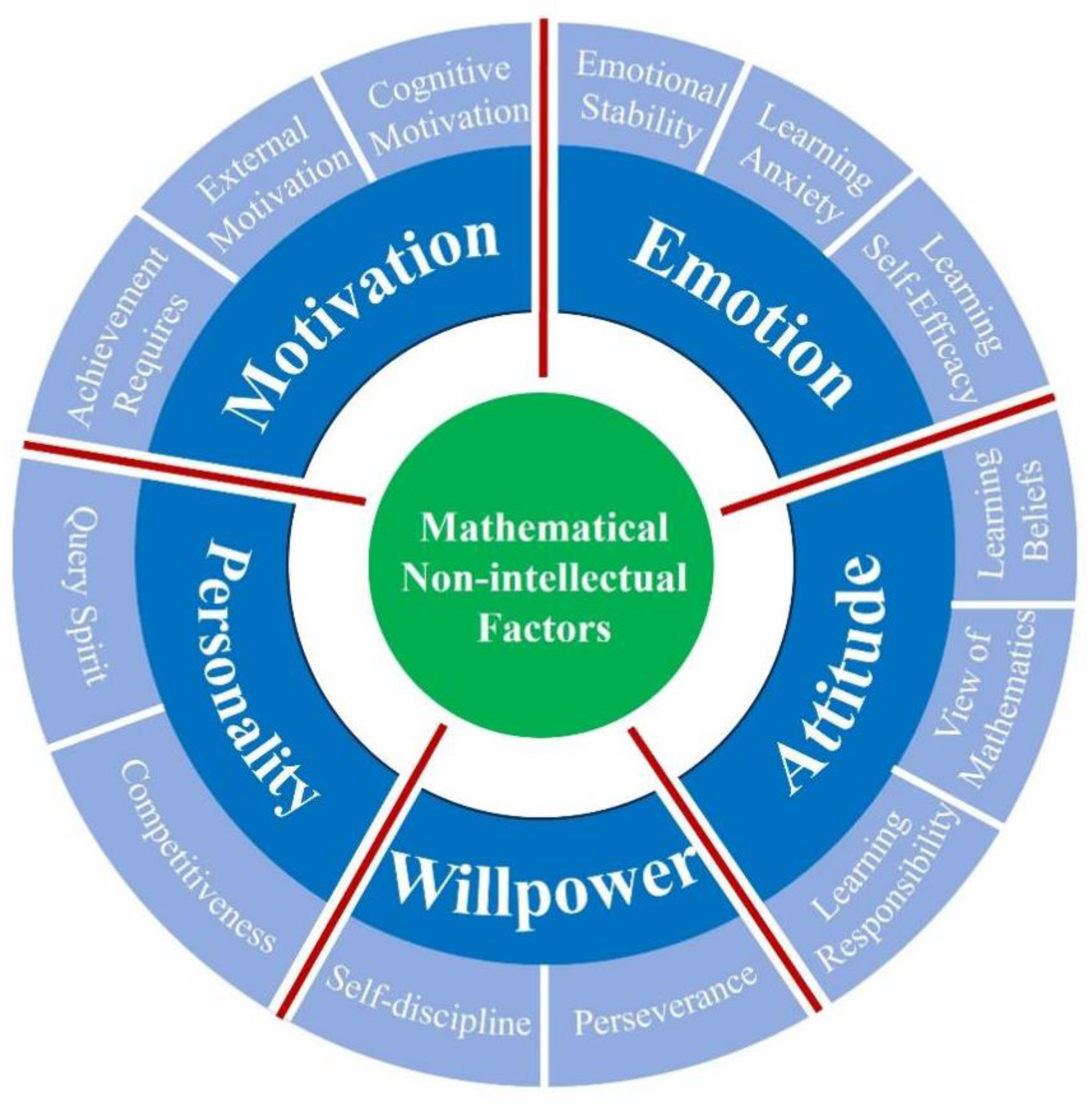



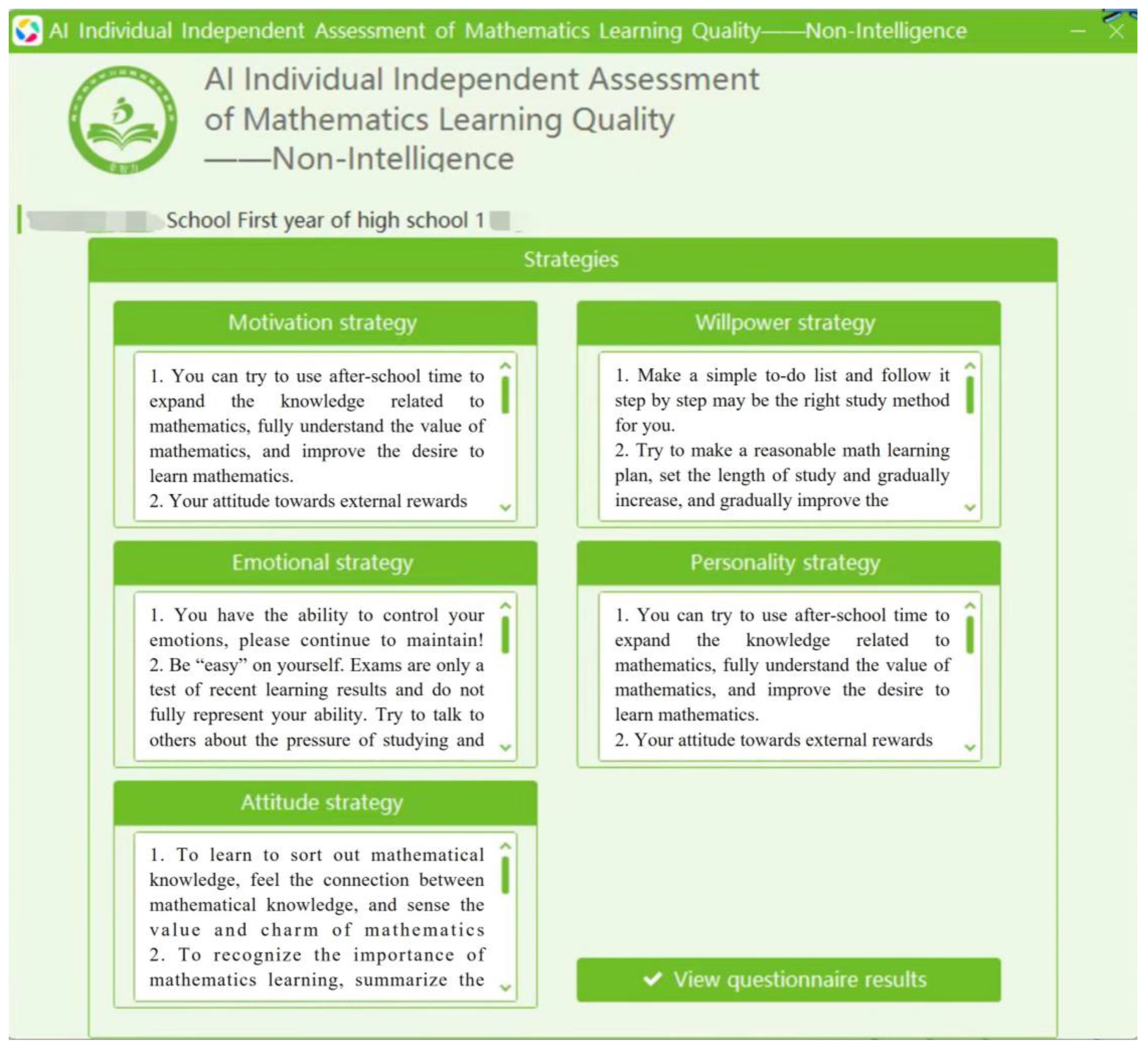

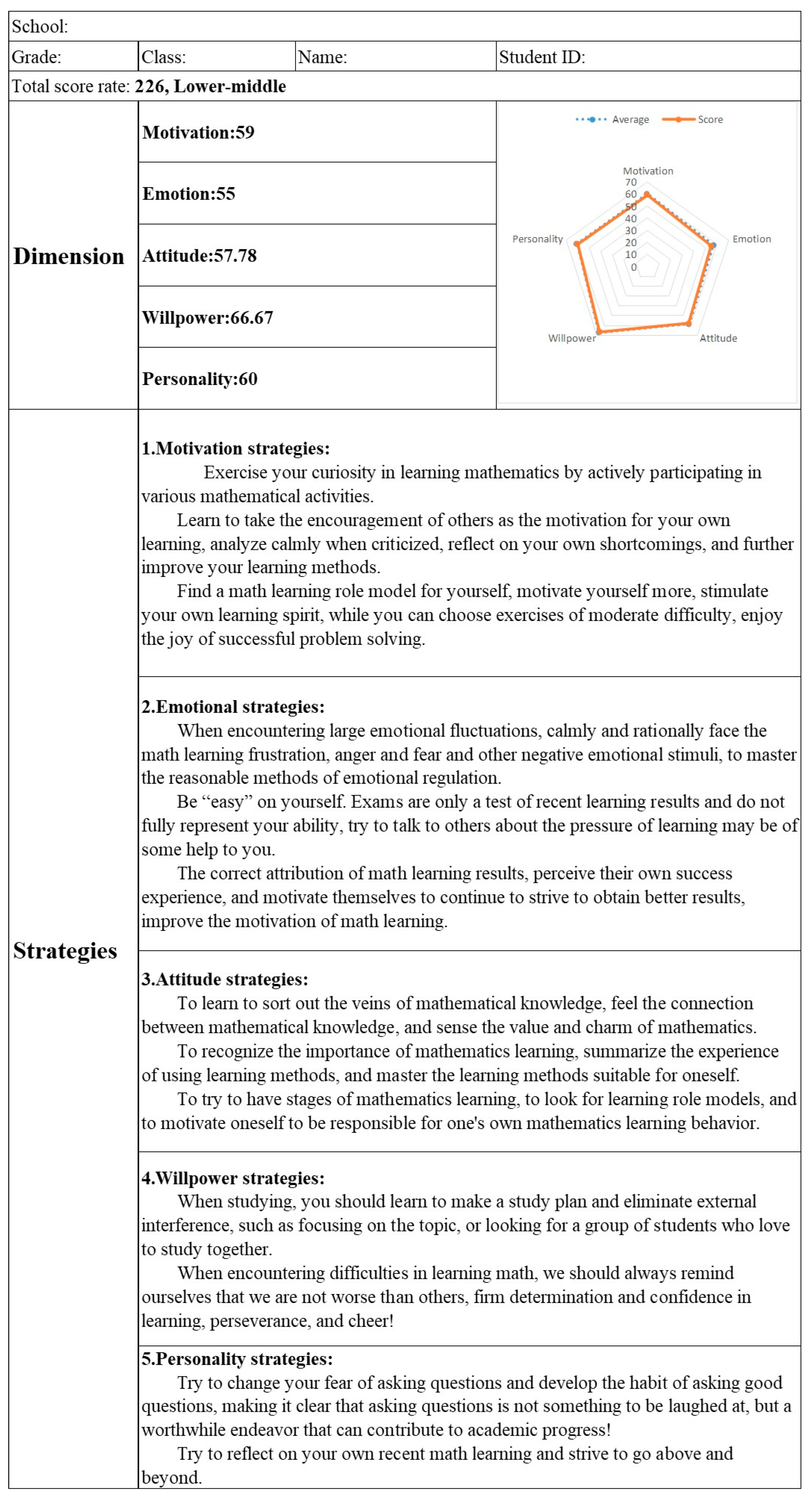
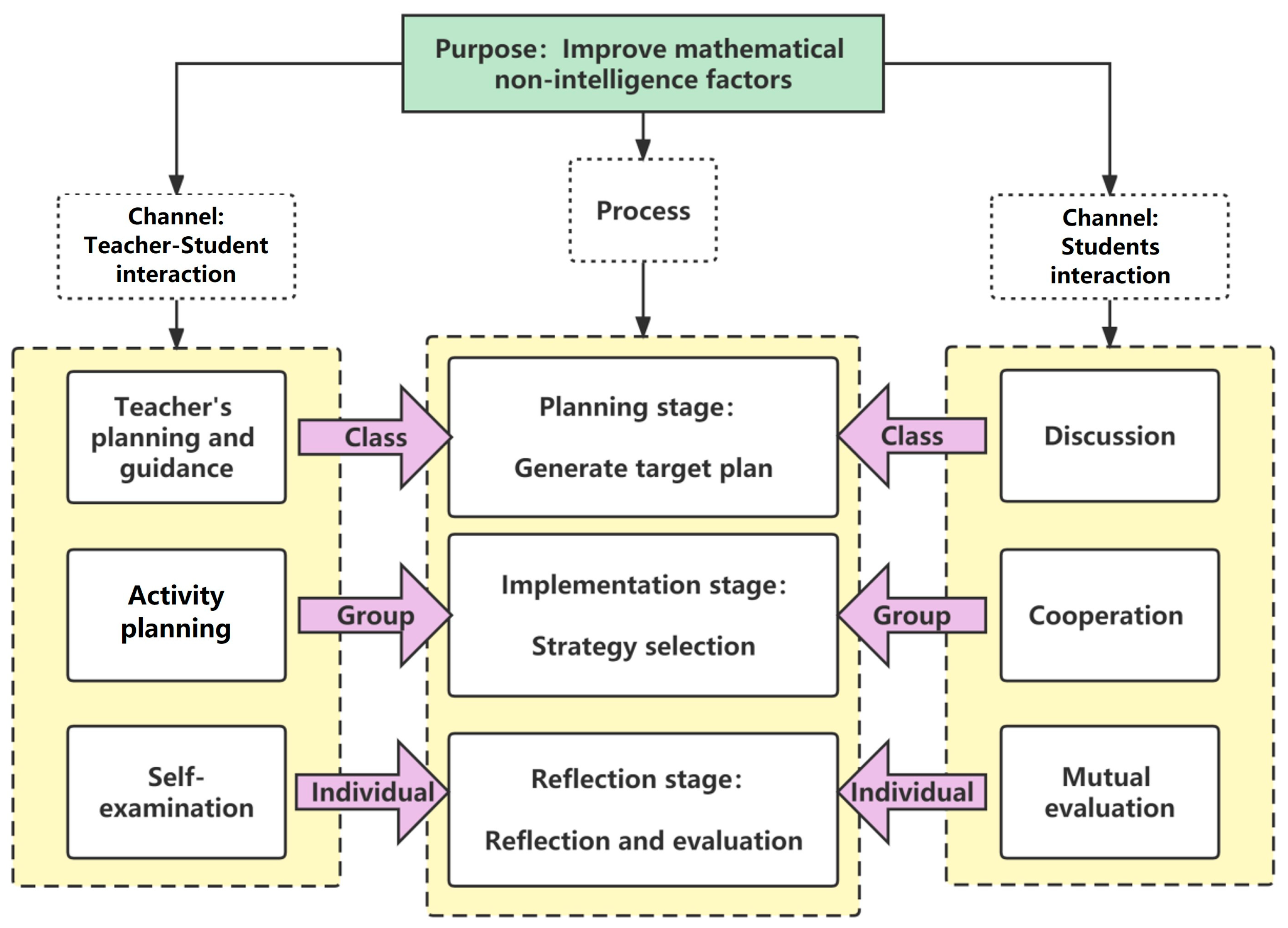
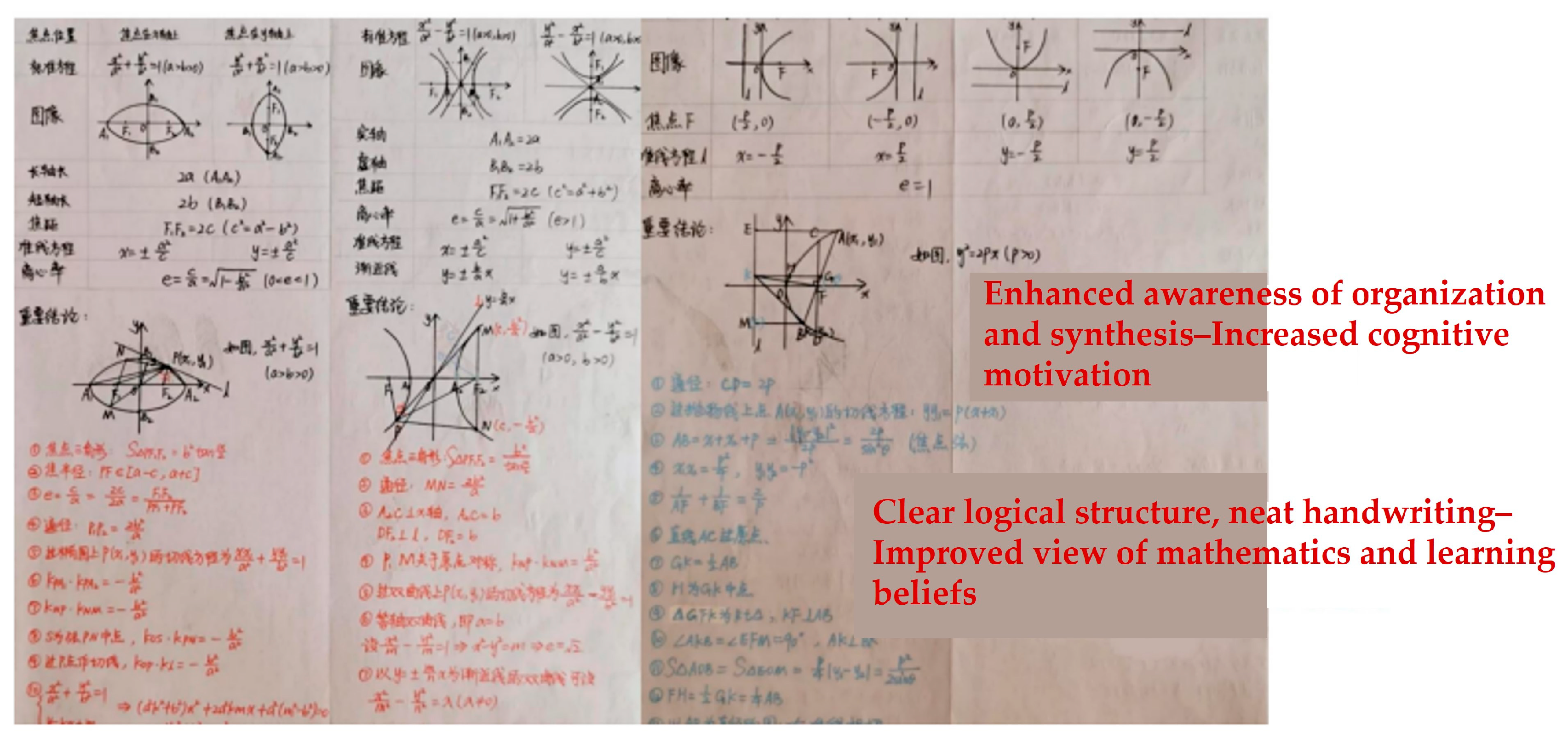
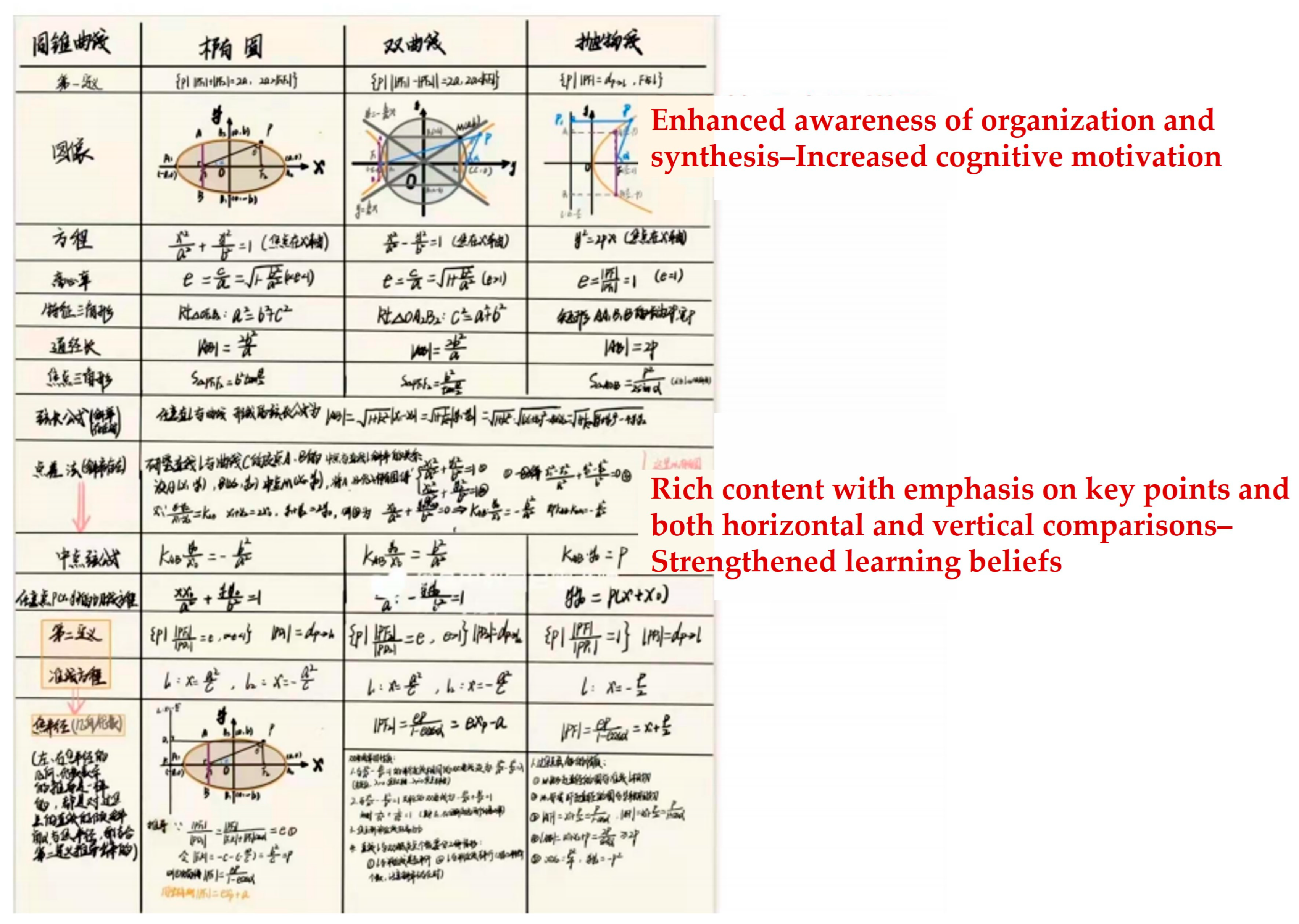
| Dimension | Cronbach’s Alpha Coefficient | Split-Half Reliability | Test-Retest Reliability |
|---|---|---|---|
| Non-intellectual factors in mathematics | 0.940 | 0.955 | 0.857 |
| Motivation | 0.904 | 0.791 | 0.805 |
| Emotion | 0.900 | 0.791 | 0.788 |
| Attitude | 0.864 | 0.865 | 0.812 |
| Willpower | 0.802 | 0.848 | 0.794 |
| Personality | 0.737 | 0.764 | 0.794 |
| Dimension | Non-Intellectual Factors in Mathematics | Motivation | Emotion | Attitude | Willpower | Personality |
|---|---|---|---|---|---|---|
| Non-intellectual factors in mathematics | 1 | |||||
| Motivation | 0.868 *** | 1 | ||||
| Emotion | 0.773 *** | 0.594 *** | 1 | |||
| Attitude | 0.842 *** | 0.683 *** | 0.705 *** | 1 | ||
| Willpower | 0.753 *** | 0.687 *** | 0.502 *** | 0.746 *** | 1 | |
| Personality | 0.776 *** | 0.587 *** | 0.506 *** | 0.535 *** | 0.535 *** | 11 |
| Principal Dimension | Sub-Dimension | Number of Questions |
|---|---|---|
| Motivation-A (100 points) | Cognitive Motivation-A1 (45 points) | 9 |
| External Motivation-A2 (20 points) | 4 | |
| Achievement Required-A3 (35 points) | 7 | |
| Emotion-B (100 points) | Emotional Stability-B1 (25 points) | 5 |
| Learning Anxiety-B2 (40 points) | 8 | |
| Learning Self-Efficacy-B3 (35 points) | 7 | |
| Attitude-C (90 points) | View of Mathematics-C1 (35 points) | 7 |
| Learning Beliefs-C2 (25 points) | 5 | |
| Learning Responsibility-C3 (30 points) | 6 | |
| Willpower-D (45 points) | Self-discipline-D1 (25 points) | 5 |
| Perseverance-D2 (20 points) | 4 | |
| Personality-E (50 points) | Query Spirit-E1 (30 points) | 6 |
| Competitiveness-E2 (20 points) | 4 |
| Dimension | Performance | Suggestion | |
|---|---|---|---|
| Motivation-A (100 points) | Cognitive Motivation-A1 (45 points) | High level (X > 35): H-A1 | S-A1 |
| Medium level (29 ≤ X ≤ 35): M-A1 Low level (X < 2 9): L-A1 | S-A2 | ||
| External Motivation-A2 (20 points) | High level (X > 14): H-A2 | S-A3 | |
| Medium level (10 ≤ X ≤ 14): M-A2 Low level (X < 10): L-A2 | S-A4 | ||
| S-A5 | |||
| Achievement Requires-A3 (35 points) | High level (X > 29): H-A3 | S-A6 | |
| Medium level (24 ≤ X ≤ 29): M-A3 Low level (X < 24): L-A3 | S-A7 | ||
| Emotion-B (100 points) | Emotional Stability-B1 (25 points) | High level (X > 22): H-B1 | S-B1 |
| Medium level (17 ≤ X ≤ 22): M-B1 Low level (X < 17): L-B1 | S-B2 | ||
| Learning Anxiety-B2 (40 points) | High level (X > 32): H-B2 | S-B3 | |
| Medium level (26 ≤ X ≤ 32): M-B2 Low level (X < 26): L-B2 | S-B4 | ||
| Learning Self-Efficacy-B3 (35 points) | High level (X > 26): H-B3 | S-B5 | |
| Medium level (21 ≤ X ≤ 26): M-B3 Low level (X < 21): L-B3 | S-B6 | ||
| Attitude-C (90 points) | View of Mathematics-C1 (35 points) | High level (X > 29): H-C1 | S-C1 |
| Medium level (23 ≤ X ≤ 29): M-C1 Low level (X < 23): L-C1 | S-C2 | ||
| Learning Beliefs-C2 (25 points) | High level (X > 22): H-C2 | S-C3 | |
| Medium level (18 ≤ X ≤ 22): M-C2 Low level (X < 18): L-C2 | S-C4 | ||
| Learning Responsibility-C3 (30 points) | High level (X > 26): H-C3 | S-C5 | |
| Medium level (22 ≤ X ≤ 26): M-C3 Low level (X < 22): L-C3 | S-C6 | ||
| Willpower-D (45 points) | Self-discipline-D1 (25 points) | High level (X > 21): H-D1 | S-D1 |
| Medium level (17 ≤ X ≤ 21): M-D1 Low level (X < 17): L-D1 | S-D2 | ||
| Perseverance-D2 (20 points) | High level (X > 17): H-D2 | S-D3 | |
| Medium level (13 ≤ X ≤ 17): M-D2 Low level (X < 13): L-D2 | S-D4 | ||
| Personality-E (50 points) | Query Spirit-E1 (30 points) | High level (X > 22): H-E1 | S-E1 |
| Medium level (19 ≤ X ≤ 22): M-E1 Low level (X < 19): L-E1 | S-E2 | ||
| Competitiveness-E2 (20 points) | High level (X > 14): H-E2 | S-E3 | |
| Medium level (12 ≤ X ≤ 14): M-E2 Low level (X < 12): L-E2 | S-E4 | ||
| Class | Number of Cases | Mean Score | Level | Rankings |
|---|---|---|---|---|
| Class I | 34 | 272.71 | Middle | 1 |
| Class II | 43 | 253.44 | Middle | 10 |
| Class III | 39 | 264.75 | Middle | 6 |
| Class IV | 26 | 263.04 | Middle | 7 |
| Class V | 37 | 262.11 | Middle | 9 |
| Class VI | 40 | 262.81 | Middle | 8 |
| Class VII | 41 | 271.21 | Middle | 3 |
| Class VIII | 38 | 269.69 | Middle | 4 |
| Class IX | 42 | 272.60 | Middle | 2 |
| Class X | 34 | 264.95 | Middle | 5 |
| Class XI | 40 | 223.78 | Lower-middle | 12 |
| Class XII | 44 | 249.86 | Middle | 11 |
| Intervention Content | Intervention Stages | Teacher–Student Interaction | Student–Student Interaction |
|---|---|---|---|
| Intervention 1—Recognizing non-intellectual factors in mathematics learning | Planning stage | (1) Teachers set intervention goals. (2) Teachers design ice-breaking activities (e.g., Stickman Rush, Intelligent Roll Call) to stimulate group dynamics. | Students discuss and negotiate to set goals. |
| Finalize the objectives: (1) Understand the components of non-intellectual factors in mathematics learning based on the information provided by the teacher. (2) Analyze personal challenges in mathematics learning based on these components and the personal diagnostic report. | |||
| Implementation stage | Activity 1: Case Study Presentation—The Pity of Zhong Yong Activity 2: Teacher-Led Inquiry | Activity 1: Read materials provided by the teacher to understand the non-intellectual factors in mathematics learning. Activity 2: Students share their views and analyze the task. | |
| Reflection stage | Activity: Complete the Feedback Form on Intervention and Improvements for Non-intellectual Factors in Mathematics Learning. | Activity: Student Self-Evaluation Time | |
| Intervention 2—Motivational dimension: fun math, happy learning | Planning stage | Teachers set intervention goals. | Students discuss and negotiate to set goals. |
| Finalize the objectives: (1) Search for mathematics-related books (including the history of mathematics, fun mathematical puzzles, mathematical novels, etc.), gain a basic understanding of the content, and choose sections to read during extracurricular time to enhance interest in mathematics and understanding of the subject. (2) Learn about world-renowned mathematicians and their outstanding achievements and explore the connections between their work and what has been learned to stimulate curiosity and enhance the need for achievement in mathematics learning. | |||
| Implementation stage | Activity 1: Möbius Strip Activity 2: Drawing Ellipses with Origami | Strategy Options: S-A2, S-A7 (Table 4) | |
| Activity 1: What Do You Know About Mathematicians? Activity 2: Setting Mathematics Learning Goals | |||
| Reflection stage | Review the key points of the lesson and re-emphasize the important role of motivation in effective mathematics learning and personal growth. | ||
| Intervention 3—Emotional dimension: I am in charge of my emotions | Planning stage | Teachers set intervention goals. | Students discuss and negotiate to set goals. |
| Finalize the objectives: (1) Reflect on past mathematics learning experiences, build confidence through memorable successes, and relive the successful experience of learning mathematics. (2) Apply the theory of attributing success and failure by reflecting on gains and losses in the midterm mathematics exam. (3) Share mathematics learning experiences, learn from each other, explore personalized learning strategies, and identify new breakthroughs. | |||
| Implementation stage | Activity 1: Strengths Savings Bank Activity 2: Attribution Training Activity 3: Mathematics Learning Strategies Exchange Conference | Strategy Options: S-B5, S-B7 (Table 4) | |
| Activity 1: Strengths Bombardment Activity 2: Attribution Training for Midterm Exam Success or Failure | |||
| Reflection stage | Review the key points of the lesson and re-emphasize the important role of emotions in mathematics learning and their impact on learning efficiency and personal growth. | ||
| Intervention 4—Attitude dimension: attitude determines altitude, and details determine success | Planning stage | Teachers set intervention goals. | Students discuss and negotiate to set goals. |
| Finalize the objectives: Construct connections between different chapters of mathematical knowledge (e.g., ellipse, hyperbola, and parabola in the conic sections chapter), begin creating a mind map, and form a network of mathematical knowledge. | |||
| Implementation stage | Activity 1: The Nature of Mathematics Activity 2: The Value of Mathematics | Strategy Selection: S-C2 (Table 4) | |
| Activity: Create a Mathematical Knowledge Mind Map | |||
| Reflection stage | Review the key points of the lesson and re-emphasize the role of attitudes in enhancing the efficiency of mathematics learning and fostering personal growth. | ||
| Intervention 5—Willpower dimension: giving up is easy, but perseverance is cool | Planning stage | Teachers set intervention goals. | Students discuss and negotiate to set goals. |
| Finalize the objectives: (1) Understand that willpower is an important factor in improving the effectiveness of mathematics learning. (2) Select role models in mathematics learning. (3) Develop a mathematics study plan. | |||
| Implementation stage | Activity: Explore the Lives of Mathematicians | Strategy Selection: S-D2 (Table 4) | |
| Activity 1: The Power of Role Models Activity 2: Develop a Small Plan | |||
| Reflection stage | Review the key points of the lesson and re-emphasize the importance of willpower in enhancing the efficiency of mathematics learning and personal growth. | ||
| Intervention 6—Personality dimension: challenging authority, and challenging self | Planning stage | Teachers set intervention goals. | Students discuss and negotiate to set goals. |
| Finalize the objectives: Organize competitive activities and encourage class members to participate in groups. | |||
| Implementation stage | Activity: Use mathematics learning as an example to discuss perspectives on “involution”. | Strategy Selection: S-E5 (Table 4) | |
| Activity 1: Class Math Knowledge Quiz Activity 2: Math Modeling Simulation | |||
| Reflection stage | Review the key points of the lesson and re-emphasize the importance of personality in enhancing the efficiency of mathematics learning and personal growth. | ||
| Groups | N | Effect | Number | Percentage |
|---|---|---|---|---|
| Experimental group 1 | 43 | Improved | 35 | 81.39% |
| Not improved (including unchanged) | 8 | 18.61% | ||
| Experimental group 2 | 40 | Improved | 32 | 80.00% |
| Not improved (including unchanged) | 8 | 20.00% | ||
| Control group | 44 | Improved | 9 | 20.45% |
| Not improved (including unchanged) | 35 | 79.55% |
Disclaimer/Publisher’s Note: The statements, opinions and data contained in all publications are solely those of the individual author(s) and contributor(s) and not of MDPI and/or the editor(s). MDPI and/or the editor(s) disclaim responsibility for any injury to people or property resulting from any ideas, methods, instructions or products referred to in the content. |
© 2024 by the authors. Licensee MDPI, Basel, Switzerland. This article is an open access article distributed under the terms and conditions of the Creative Commons Attribution (CC BY) license (https://creativecommons.org/licenses/by/4.0/).
Share and Cite
Kang, Y.; Wang, G.; Liu, L.; Liu, J.; Gao, Q. The Development and Application of an Intelligent Assessment and Strategy Implementation System for Non-Intellectual Factors in Mathematics Learning Among Senior High School Students. J. Intell. 2024, 12, 126. https://doi.org/10.3390/jintelligence12120126
Kang Y, Wang G, Liu L, Liu J, Gao Q. The Development and Application of an Intelligent Assessment and Strategy Implementation System for Non-Intellectual Factors in Mathematics Learning Among Senior High School Students. Journal of Intelligence. 2024; 12(12):126. https://doi.org/10.3390/jintelligence12120126
Chicago/Turabian StyleKang, Yueyuan, Guangming Wang, Luxuan Liu, Jing Liu, and Qianqian Gao. 2024. "The Development and Application of an Intelligent Assessment and Strategy Implementation System for Non-Intellectual Factors in Mathematics Learning Among Senior High School Students" Journal of Intelligence 12, no. 12: 126. https://doi.org/10.3390/jintelligence12120126
APA StyleKang, Y., Wang, G., Liu, L., Liu, J., & Gao, Q. (2024). The Development and Application of an Intelligent Assessment and Strategy Implementation System for Non-Intellectual Factors in Mathematics Learning Among Senior High School Students. Journal of Intelligence, 12(12), 126. https://doi.org/10.3390/jintelligence12120126




